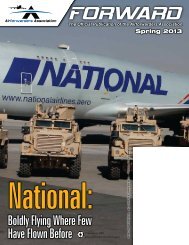THE DESCARTES SYSTEMS GROUP INC.
THE DESCARTES SYSTEMS GROUP INC.
THE DESCARTES SYSTEMS GROUP INC.
Create successful ePaper yourself
Turn your PDF publications into a flip-book with our unique Google optimized e-Paper software.
including our estimated taxable income, our history of losses for tax purposes, our tax planning strategies and the<br />
likelihood of success of our tax filing positions, among others. A change to any of these factors could impact the<br />
estimated valuation allowance and income tax expense.<br />
Effective February 1, 2007, we adopted ASC Subtopic 740-10 “Accounting for Uncertainty in Income Taxes—an<br />
interpretation of FASB Statement No. 109” (“ASC Subtopic 740”) which prescribes a recognition threshold and<br />
measurement attribute for the financial statement recognition and measurement of a tax position taken or expected<br />
to be taken in a tax return. ASC Subtopic 740 also provides accounting guidance on derecognition, classification,<br />
interest and penalties, accounting in interim periods, disclosure and transition. The accounting for ASC Subtopic<br />
740 is described more fully in Note 17 below.<br />
Earnings per share<br />
Basic earnings per share is calculated by dividing net income by the weighted average number of common shares<br />
outstanding during the period. Diluted earnings per common share is calculated by dividing net income by the<br />
sum of the weighted average number of common shares outstanding and all additional common shares that would<br />
have been outstanding if potentially dilutive common shares had been issued during the period. The treasury stock<br />
method is used to compute the dilutive effect of stock options.<br />
Recently adopted accounting pronouncements<br />
In January 2010, the FASB issued Accounting Standards Update (“ASU”) 2010-06, “Improving Disclosures<br />
about Fair Value Measurements” (“ASU 2010-06”). ASU 2010-06 amends ASC Topic 820, “Fair Value<br />
Measurements and Disclosures” (“ASC Topic 820”) to add new requirements for disclosures about transfers into<br />
and out of Level 1 and 2 and separate disclosures about purchases, sales, issuances and settlements relating to<br />
Level 3 measurements. The ASU also clarifies existing fair value disclosures about the level of disaggregation<br />
and about inputs and valuation techniques used to measure fair value. ASU 2010-06 is effective for the first<br />
reporting period beginning after December 15, 2009, which was our reporting period ended April 30, 2010,<br />
except for the requirement to provide the Level 3 activity of purchases, sales issuances, and settlements on a gross<br />
basis, which is effective for fiscal years beginning after December 15, 2010, which is our fiscal year beginning<br />
February 1, 2011. The adoption of ASU 2010-06 has not had a material impact on our results of operation or<br />
financial condition to date and we do not anticipate the requirement to provide the Level 3 activity on a gross<br />
basis to materially impact the consolidated financial statements as we have not historically held any instruments<br />
requiring Level 3 measurements.<br />
Recently issued accounting pronouncements not yet adopted<br />
In October 2009, the FASB issued ASU 2009-13, “Multiple Deliverable Revenue Arrangements a consensus of<br />
the FASB Emerging Issues Task Force” (“ASU 2009-13”). ASU 2009-13 amends ASC Subtopic 605-25<br />
“Revenue Recognition: Multiple-Element Arrangements”. Specifically ASU 2009-13 amends the criteria for<br />
separating consideration in multiple-deliverable arrangements and establishes a selling price hierarchy for<br />
determining the selling price of a deliverable. The selling price used for each deliverable will be based on vendorspecific<br />
objective evidence if available, third-party evidence if vendor-specific objective evidence is not available,<br />
or estimated selling price if neither vendor-specific objective evidence nor third-party evidence is available. The<br />
guidance eliminates the use of the residual method, requires entities to allocate revenue using the relative-sellingprice<br />
method, and significantly expands the disclosure requirements for multiple-deliverable revenue<br />
arrangements. ASU 2009-13 is effective for fiscal years beginning on or after June 15, 2010, which is our fiscal<br />
year beginning February 1, 2011 and will be adopted prospectively. The adoption of this amendment is not<br />
expected to have a material impact on our results of operations.<br />
In October 2009, the FASB issued ASU 2009-14, “Certain Revenue Arrangements That Include Software<br />
Elements” (“ASU 2009-14”). ASU 2009-14 changes the accounting model for revenue arrangements that include<br />
both tangible products and software elements. Tangible products containing both software and non-software<br />
components that function together to deliver the product’s essential functionality will no longer be within the<br />
scope of ASC Subtopic 985-605, “Software Revenue Recognition”. The entire product, including the software<br />
and non-software deliverables, will therefore be accounted for under ASC Topic 605, “Revenue Recognition”.<br />
53



